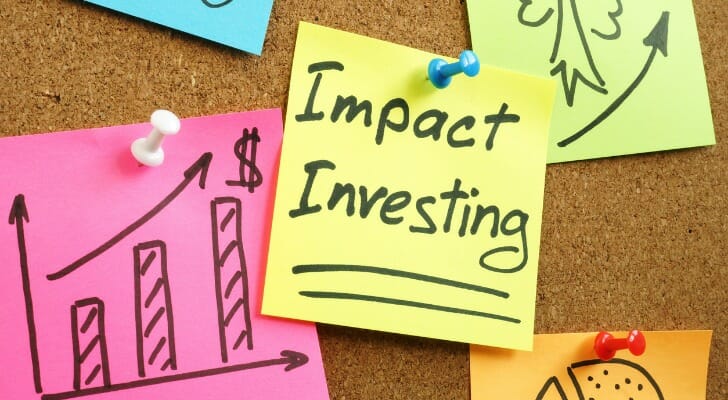Impact investing is a strategy that aims to create a positive social or environmental impact while also providing competitive financial returns. Impact investors may buy shares of a company that promotes women more frequently than other firms or avoid purchasing bonds issued by a weapons manufacturer. Unlike philanthropy, which seeks to advance a social or other agenda by donating money without hope of financial gain, impact investing requires a financial return comparable to other investments. Impact investors also often require some sort of measurement of the effect of their investments on their social or environmental goals. For help with your impact investing decisions, consider working with a financial advisor.
Basics of Impact Investing
Impact investing is one of the thematic investing styles. Other thematic investing approaches may focus on a particular industry such as healthcare or a social trend, such as the shift to e-commercial, where it is hoped superior financial returns can be found. Impact investing is distinguished from other themes by the investor’s desire to accomplish or encourage a specific change in the world in addition to earning a strong return on the investment.
Philanthropic giving similarly aims to advance social causes such as gender equity or environmental concerns such as global warming. However, impact investing is different because it seeks to earn competitive financial returns in addition to promoting positive change. Philanthropy’s objective is never to return financial benefits to the giver.
Impact investing also resembles environmental, social and governance (ESG) investing. ESG investors and impact investors often invest in the same companies, such as those developing carbon-free energy technologies or providing access to financial services for chronically unbanked communities. However, ESG investing is driven by the idea that companies that do good will do better financially than those that exploit the environment or manufacture products that harm people. It is more about generating superior returns than creating desirable change.
Impact investing is not a specific asset class and may involve a broad range of asset types. Impact investors may put their money into stocks, bonds, mutual funds or ETFs. They may loan money to microfinance initiatives or other organizations that aim to help people with inadequate resources.
Impact investors are often individuals, but may also be organizations that have social or environmental influence as a goal. Foundations, governments, nonprofits, pension funds, religious institutions, banks, family offices and mutual funds are among those that may act as impact investors.
How Impact Investing Impacts Investment Choices

There are two ideas behind impact investing. First, by providing financial resources preferentially to organizations that further desirable goals or at least avoid undesirable results, investors will increase the chances that the changes they want to see will become reality. Second, impact investors want to achieve competitive financial returns.
For instance, an impact investor might purchase shares of a company that develops food products that can substitute for meat, based on the understanding that foods derived from animals damage the environment more than plant-based foods. Alternatively, the investor might avoid buying bonds issued by a meatpacking company.
Impact investors may seek to further any number of social or environmental objectives, including:
- Reducing human carbon emissions through solar or wind power,
- Mitigating climate change through carbon sequestration,
- Reducing water consumption,
- Equalizing opportunity for people of all genders, races, ethnicities and other groups,
- Encouraging practices promoted by religious faiths,
- Improving access to health, financial or other services in underprivileged communities.
In addition to providing additional financial resources to activities they want to strengthen, impact investors may put as much effort into avoiding giving support to industries, companies or activities they consider to be negative. Impact investors often avoid investing in organizations engaged in:
- Environmental exploitation
- Pornography
- Alcohol
- Tobacco
- Gambling
- Firearms
- Predatory financial practices
To execute their investment strategy, investors can purchase shares of individual companies or bonds issued by individual companies. However, many take advantage of the convenience and diversification offered by mutual funds and exchange-traded funds designed to follow specific impact investing strategies. Funds are available that seek to advance carbon mitigation, gender equity, renewable energy and many other impact investing themes.
Impact Investing Returns
Impact investing has two goals: positive change and competitive returns. With regard to the first, impact investors have developed a number of methods for measuring the effectiveness of their investments on advancing their social and other objectives. For example, an investor seeking to reduce homelessness by purchasing shares of a developer of low-priced housing might look for changes in the measured number of homeless people in communities where the developer is active.
Concerning the requirement for a profitable investment, impact investors use measurements familiar to all investors, such as return on investment. Many studies of the financial performance of impact investing portfolios support the idea that impact investing can yield returns competitively with strategies passed solely on generating profit.
The Bottom Line

Impact investing is a style that describes how investors direct their financial resources to causes they support, while also denying support to undesirable activities. To accomplish this, impact investors may purchase shares of companies that they see as promoting desirable outcomes while avoiding companies engaged in making or distributing products and services that are undesirable. Impact investors also want to see financial performance competitive with other investing approaches.
Tips for Investing
- A financial advisor can help you identify investments that meet your impact and financial return needs. Finding the right financial advisor who fits your needs doesn’t have to be hard. SmartAsset’s free tool matches you with up to three financial advisors who serve your area, and you can interview your advisor matches at no cost to decide which one is right for you. If you’re ready to find an advisor who can help you achieve your financial goals, get started now.
- Although impact investors seek to do good as they perceive it, certain impact investing activities may conflict with impact investors who have different ideas about what is good. The returns are still a necessary part of a good impact investing strategy. You can use SmartAsset’s investment calculator to get a rough estimate of what an impact portfolio could look like.
©iStock.com/designer491, ©iStock.com/BlackSalmon, ©iStock.com/Ijubaphoto
